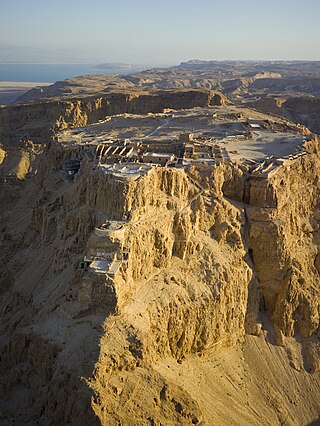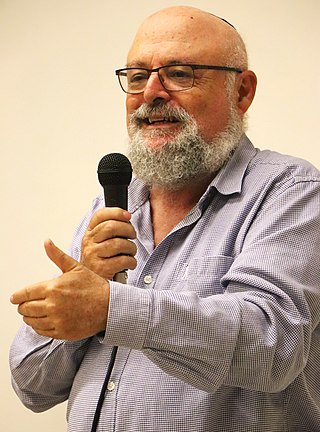Related Research Articles
The Essenes were a mystic Jewish sect during the Second Temple period that flourished from the 2nd century BCE to the 1st century CE.
The Sicarii were a splinter group of the Jewish Zealots who, in the decades preceding Jerusalem's destruction in 70 CE, strongly opposed the Roman occupation of Judea and attempted to expel them and their sympathizers from the area. The Sicarii carried sicae, or small daggers, concealed in their cloaks. At public gatherings, they pulled out these daggers to attack Romans and alleged Roman sympathizers alike, blending into the crowd after the deed to escape detection.

The Messiah in Judaism is a savior and liberator figure in Jewish eschatology who is believed to be the future redeemer of the Jews. The concept of messianism originated in Judaism, and in the Hebrew Bible a messiah is a king or High Priest of Israel traditionally anointed with holy anointing oil. However, messiahs were not exclusively Jewish, as the Hebrew Bible refers to Cyrus the Great, Achaemenid Emperor, as a messiah for his decree to rebuild the Jerusalem Temple.

The First Jewish–Roman War, sometimes called the Great Jewish Revolt, or The Jewish War, was the first of three major rebellions by the Jews against the Roman Empire fought in Roman-controlled Judea, resulting in the destruction of Jewish towns, the displacement of its people and the appropriation of land for Roman military use, as well as the destruction of the Jewish Temple and polity.
The Zealots were a political movement in 1st-century Second Temple Judaism which sought to incite the people of Judea Province to rebel against the Roman Empire and expel it from the Holy Land by force of arms, most notably during the First Jewish–Roman War (66–70). Zealotry was the term used by Josephus for a "fourth sect" or "fourth Jewish philosophy" during this period.

The siege of Masada was one of the final events in the First Jewish–Roman War, occurring from 72 to 73 CE on and around a hilltop in present-day Israel.

The Davidic line or House of David is the lineage of the Israelite king David. In Judaism it is based on texts from the Hebrew Bible and through the succeeding centuries based on later traditions.

Most scholars who study the historical Jesus and early Christianity believe that the canonical gospels and the life of Jesus must be viewed within their historical and cultural context, rather than purely in terms of Christian orthodoxy. They look at Second Temple Judaism, the tensions, trends, and changes in the region under the influence of Hellenism and the Roman occupation, and the Jewish factions of the time, seeing Jesus as a Jew in this environment; and the written New Testament as arising from a period of oral gospel traditions after his death.
Judas of Galilee, or Judas of Gamala, was a Jewish leader who led resistance to the census imposed for Roman tax purposes by Quirinius in the Judaea Province in 6 CE. He encouraged Jews not to register and those that did had their houses burnt and their cattle stolen by his followers. He is credited with beginning the "fourth philosophy" of the Jews which Josephus blames for the disastrous war with the Romans in 66–73. These events are discussed by Josephus in The Jewish War and in Antiquities of the Jews and mentioned in the Acts of the Apostles.

The Jewish–Roman wars were a series of large-scale revolts by the Jews of Judaea and the Eastern Mediterranean against the Roman Empire between 66 and 135 CE. The First Jewish–Roman War and the Bar Kokhba revolt were nationalist rebellions, striving to restore an independent Judean state, while the Kitos War was more of an ethno-religious conflict, mostly fought outside the province of Judaea. As a result, there is variation in the use of the term "Jewish-Roman wars." Some sources exclusively apply it to the First Jewish-Roman War and the Bar Kokhba revolt, while others include the Kitos War as well.
The Star Prophecy is a Messianic reading applied by Jewish Zealots and early Christians to Numbers 24:17.
Simon bar Giora was the leader of one of the major Judean rebel factions during the First Jewish–Roman War in 1st-century Roman Judea, who vied for control of the Jewish polity while attempting to expel the Roman army, but incited a bitter internecine war in the process.

Israel Knohl is an Israeli Bible scholar and historian. He is the Yehezkel Kaufmann Professor of Biblical studies at the Hebrew University of Jerusalem and a Senior Fellow at Shalom Hartman Institute in Jerusalem. His books deal with the integration of scientific and archaeological discoveries with the biblical account, early Israelite beliefs, a survey of Israelite cult, and how and where the Israelites originated.

Robert Eisenman is an American biblical scholar, historian, archaeologist, and poet. He is currently professor of Middle East religions, archaeology, and Islamic law and director of the Institute for the Study of Judaeo-Christian Origins at California State University Long Beach.

The Teacher of Righteousness is a mysterious figure found in some of the Dead Sea Scrolls at Qumran, most prominently in the Damascus Document. This document speaks briefly of the origins of the sect, probably Essenes, 390 years after the reign of Nebuchadnezzar and after 20 years of looking blindly for the way. "God... raised for them a Teacher of Righteousness to guide them in the way of His heart".
In Jewish eschatology Mashiach ben Yoseph or Messiah ben Joseph, also known as Mashiach bar/ben Ephraim, is a Jewish messiah from the tribe of Ephraim and a descendant of Joseph. The figure's origins are much debated. Some regard it as a rabbinic invention, but others defend the view that its origins are in the Torah.

Sefer Zerubavel, also called the Book of Zerubbabel or the Apocalypse of Zerubbabel, is a medieval Hebrew-language apocalypse written at the beginning of the seventh century CE in the style of biblical visions placed into the mouth of Zerubbabel, the last descendant of the Davidic line to take a prominent part in Israel's history, who laid the foundation of the Second Temple in the sixth century BCE. The enigmatic postexilic biblical leader receives a revelatory vision outlining personalities and events associated with the restoration of Israel, the End of Days, and the establishment of the Third Temple.

Gabriel's Revelation, also called Hazon Gabriel or the Jeselsohn Stone, is a stone tablet with 87 lines of Hebrew text written in ink, containing a collection of short prophecies written in the first person. It is dated to the late 1st century BCE or early 1st century CE and is important for understanding Jewish messianic expectations in the Second Temple period.
Menahem or Menachem was a Jewish king.
In the Babylonian Talmud, Menahem ben Hezekiah was a quasi-messianic Jewish teacher born on the day the Second Temple was destroyed. He may be the same as Menahem ben Judah; also see Menahem ben Ammiel.
References
- ↑ Ancient battle divides Israel as Masada 'myth' unravels; Was the siege really so heroic, asks Patrick Cockburn in Jerusalem, The Independent, 30 March 1997
- ↑ Book review digest: Volume 97 H.W. Wilson Company - 2001 "Thanks to David Maisel' s excellent English translation, we can consider Knohl's thesis. ... whom he identifies as Menahem the Essene. Knohl arrives at his hypothesis through an examination of two purportedly messianic hymns from Qumran ..."
- ↑ Israel Knohl trans. David Maisel The Messiah Before Jesus: The Suffering Servant of the Dead Sea Scrolls 2002 p.61 "Significantly, the only mention of Menahem in the Mishna occurs immediately after the remarks on the wickedness of slighting God's honor. The protagonist of the messianic hymns, whom we have identified with Menahem, describes himself "
![]() This article incorporates text from a publication now in the public domain : Singer, Isidore; et al., eds. (1901–1906). The Jewish Encyclopedia . New York: Funk & Wagnalls.
This article incorporates text from a publication now in the public domain : Singer, Isidore; et al., eds. (1901–1906). The Jewish Encyclopedia . New York: Funk & Wagnalls.{{cite encyclopedia}}: Missing or empty |title= (help) This article is an evolution of the corresponding article which gives the following Bibliography: Grätz, Gesch. passim; Hamburger, R. B. T. s.v. Messiasc; M. Gaster, in Jew. Chron. Feb. 11 and March 11, 1898; A. M. Hyamson, False Messiahs, in Gentleman's Magazine, Ixix. 79–89; Johannis à Lent, De Judœorum Pseudo-Messiis.